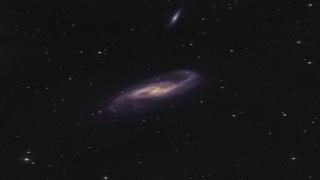Meidt, Sharon E.; Schinnerer, Eva; Muñoz-Mateos, Juan-Carlos; Holwerda, Benne; Ho, Luis C.; Madore, Barry F.; Knapen, J. H.; Bosma, Albert; Athanassoula, E.; Hinz, Joannah L.; Sheth, Kartik; Regan, Michael; Gil de Paz, Armando; Menéndez-Delmestre, Karín; Seibert, Mark; Kim, Taehyun; Mizusawa, Trisha; Gadotti, Dimitri A.; Laurikainen, Eija; Salo, Heikki; Laine, Jarkko; Comerón, Sébastien
Referencia bibliográfica
The Astrophysical Journal Letters, Volume 748, Issue 2, article id. L30 (2012).
Fecha de publicación:
4
2012
Número de citas
18
Número de citas referidas
17
Descripción
We examine the effect of circumstellar dust extinction on the near-IR
(NIR) contribution of asymptotic giant branch (AGB) stars in
intermediate-age clusters throughout the disk of M100. For our sample of
17 AGB-dominated clusters we extract optical-to-mid-IR spectral energy
distributions (SEDs) and find that NIR brightness is coupled to the
mid-IR dust emission in such a way that a significant reduction of AGB
light, of up to 1 mag in the K band, follows from extinction by the dust
shell formed during this stage. Since the dust optical depth varies with
AGB chemistry (C-rich or O-rich), our results suggest that the
contribution of AGB stars to the flux from their host clusters will be
closely linked to the metallicity and the progenitor mass of the AGB
star, to which dust chemistry and mass-loss rate are sensitive. Our
sample of clusters—each the analogue of a ~1 Gyr old
post-starburst galaxy—has implications within the context of mass
and age estimation via SED modeling at high-z: we find that the average
~0.5 mag extinction estimated here may be sufficient to reduce the AGB
contribution in the (rest-frame) K band from ~70%, as predicted in the
latest generation of synthesis models, to ~35%. Our technique for
selecting AGB-dominated clusters in nearby galaxies promises to be
effective for discriminating the uncertainties associated with AGB stars
in intermediate-age populations that plague age and mass estimation in
high-z galaxies.
Proyectos relacionados

Las Galaxias Espirales: Evolución y Consecuencias
Nuestro grupo pequeño esta bien conocido y respetado internacionalmente por nuestro trabajo inovativo e importante en varios aspectos de la estructura y la evolución de las galaxias espirales cercanas. Usamos principalmente observaciones en varias longitudes de onda, explotando las sinergías que nos permiten responder a las cuestiones más
Johan Hendrik
Knapen Koelstra